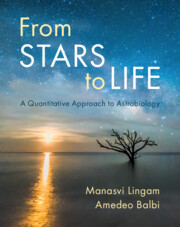Refine search
Actions for selected content:
67 results
Caves on Earth as proxies for Martian subsurface environments
-
- Journal:
- International Journal of Astrobiology / Volume 24 / 2025
- Published online by Cambridge University Press:
- 09 December 2025, e29
-
- Article
-
- You have access
- Open access
- HTML
- Export citation
Potential refugia on the Tibetan Plateau during the last glacial maximum
-
- Journal:
- Quaternary Research , First View
- Published online by Cambridge University Press:
- 05 September 2025, pp. 1-11
-
- Article
-
- You have access
- Open access
- HTML
- Export citation
The multiple extremes of temperature, salt and pH define narrower limits to microbial growth in Halomonas hydrothermalis than individual extremes
-
- Journal:
- International Journal of Astrobiology / Volume 24 / 2025
- Published online by Cambridge University Press:
- 27 August 2025, e19
-
- Article
-
- You have access
- Open access
- HTML
- Export citation
The aerobic biosphere as an O2 sink before the Great Oxygenation Event: geobiological feedback to solid Earth and surface oxidation
-
- Journal:
- Geo-Bio Interfaces / Volume 2 / 2025
- Published online by Cambridge University Press:
- 01 August 2025, e10
-
- Article
-
- You have access
- Open access
- HTML
- Export citation
Estimating the potential of ionizing radiation-induced radiolysis for microbial metabolism on terrestrial planets and satellites with rarefied atmospheres
-
- Journal:
- International Journal of Astrobiology / Volume 24 / 2025
- Published online by Cambridge University Press:
- 28 July 2025, e9
-
- Article
-
- You have access
- Open access
- HTML
- Export citation
The potential of Deception Island, Antarctica, as a multifunctional Martian analogue of astrobiological interest
-
- Journal:
- International Journal of Astrobiology / Volume 24 / 2025
- Published online by Cambridge University Press:
- 13 February 2025, e3
-
- Article
-
- You have access
- Open access
- HTML
- Export citation

From Stars to Life
- A Quantitative Approach to Astrobiology
-
- Published online:
- 22 November 2024
- Print publication:
- 05 December 2024
Habitability constraints by nutrient availability in atmospheres of rocky exoplanets
-
- Journal:
- International Journal of Astrobiology / Volume 23 / 2024
- Published online by Cambridge University Press:
- 19 April 2024, e12
-
- Article
-
- You have access
- Open access
- HTML
- Export citation
Astrobiological applications of μ-mapping X-ray fluorescence spectrometry
-
- Journal:
- International Journal of Astrobiology / Volume 23 / 2024
- Published online by Cambridge University Press:
- 04 March 2024, e8
-
- Article
-
- You have access
- Open access
- HTML
- Export citation
Astroecology: bridging the gap between ecology and astrobiology
-
- Journal:
- International Journal of Astrobiology / Volume 23 / 2024
- Published online by Cambridge University Press:
- 14 December 2023, e3
-
- Article
-
- You have access
- Open access
- HTML
- Export citation
Presence of liquid water during the evolution of exomoons orbiting ejected free-floating planets
-
- Journal:
- International Journal of Astrobiology / Volume 22 / Issue 4 / August 2023
- Published online by Cambridge University Press:
- 20 March 2023, pp. 317-346
-
- Article
-
- You have access
- Open access
- HTML
- Export citation
Planetary geodynamics and age constraints on circumstellar habitable zones around main sequence stars
-
- Journal:
- International Journal of Astrobiology / Volume 22 / Issue 4 / August 2023
- Published online by Cambridge University Press:
- 14 March 2023, pp. 272-316
-
- Article
- Export citation
13 - An Earth Standard Currency
-
- Book:
- How to Fix a Broken Planet
- Published online:
- 15 January 2023
- Print publication:
- 05 January 2023, pp 143-152
-
- Chapter
- Export citation

Understanding Life in the Universe
-
- Published online:
- 28 October 2022
- Print publication:
- 17 November 2022
The extreme southern origins of globality: Circumnavigation, habitability, and geopolitics
-
- Journal:
- Journal of Global History / Volume 18 / Issue 2 / July 2023
- Published online by Cambridge University Press:
- 12 September 2022, pp. 192-215
-
- Article
- Export citation
6 - Vertical Limits
-
- Book:
- Science on the Roof of the World
- Published online:
- 28 April 2022
- Print publication:
- 12 May 2022, pp 206-239
-
- Chapter
- Export citation
Marginally housed or marginally homeless?
-
- Journal:
- International Journal of Law in Context / Volume 18 / Issue 1 / March 2022
- Published online by Cambridge University Press:
- 06 April 2022, pp. 69-84
-
- Article
- Export citation
A brief history of the term ‘habitable zone’ in the 19th century
-
- Journal:
- International Journal of Astrobiology / Volume 20 / Issue 5 / October 2021
- Published online by Cambridge University Press:
- 25 June 2021, pp. 332-336
-
- Article
- Export citation
Habitability: a process versus a state variable framework with observational tests and theoretical implications
-
- Journal:
- International Journal of Astrobiology / Volume 20 / Issue 2 / April 2021
- Published online by Cambridge University Press:
- 21 January 2021, pp. 125-132
-
- Article
- Export citation

The Biological Universe
- Life in the Milky Way and Beyond
-
- Published online:
- 24 September 2020
- Print publication:
- 24 September 2020






